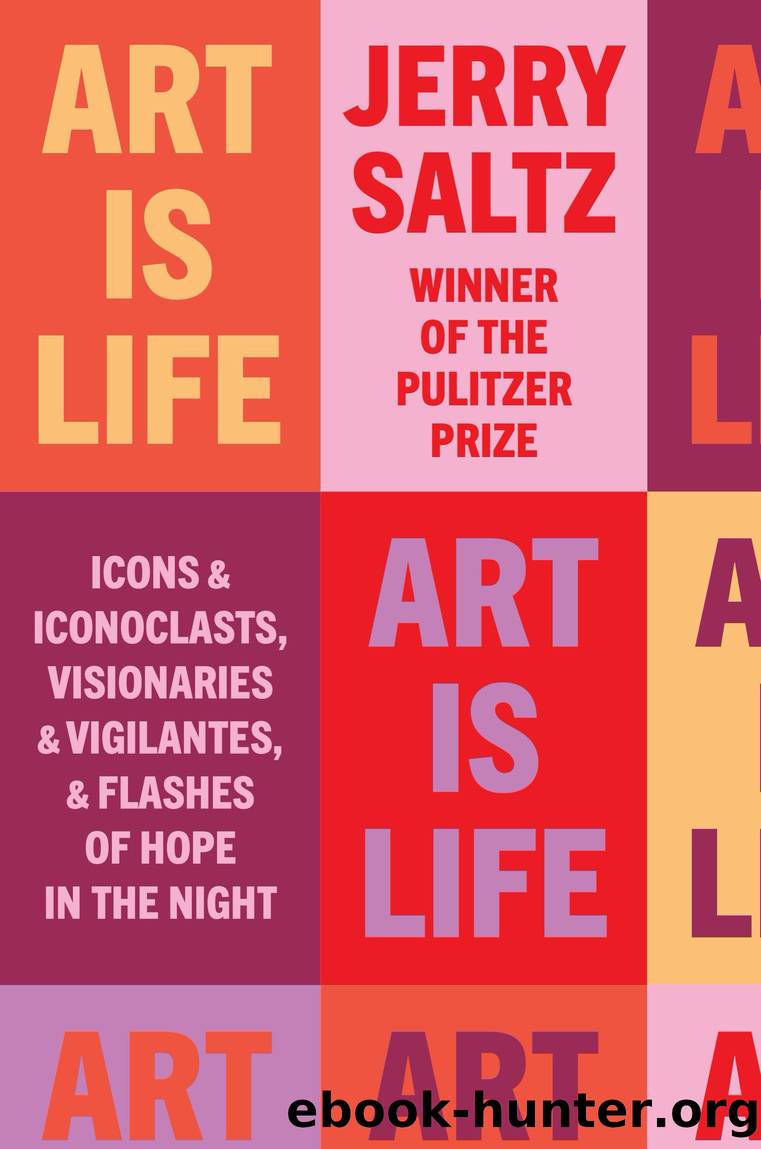Art Is Life by Jerry Saltz

Author:Jerry Saltz [Saltz, Jerry]
Language: eng
Format: epub
Publisher: Penguin Publishing Group
Published: 2022-11-02T00:00:00+00:00
How Philip Guston Reinvented the Sublime
As late as he came to the style, by 1957 Philip Guston was a highly admired first-generation Abstract Expressionistâa phrase he hated. How late to the party was Guston? In the 1940s, peers like Arshile Gorky, Franz Kline, Jackson Pollock, and Mark Rothko were already finding their ways into all-out abstraction. Yet throughout that time Guston was still experimenting with figures, grounds, solid spaces, and objects. Pollock, who attended high school with Guston in Los Angeles (the two were expelled for designing satirical leaflets) and who urged Guston to move to New York in 1935, had been making abstract paintings since 1939. Gorky had done so since 1932; Rothko and Willem de Kooning reached these farther shores by the early 1940s. Guston didnât go fully abstract until about 1950. History is lucky; had he waited a minute longer, the Ab Ex train would have left without him and we might never have heard of him.
Guston was always hesitant, and when he finally did get to real abstraction he stayed ambivalent about it. âEvery real painter wants to be, and his greatest desire is to be, a realist,â he said. The abstract works that deservedly won him fame are beautiful shimmering lyrical fields of broken brushstrokes, flickering grounds of pearly blue and pink, serene combinations of Monet and Turner with inflections of Mondrianâs early piers-reflected-in-water. But Guston started to feel that he was only taking small bites in his work. By the 1950s, he felt he âhad nowhere to go.â Saying âI hope sometime to get to the point where Iâll have the courage to paint my face . . . to paint a single form in the middle of the canvas,â he started doing exactly that. And he had the courage to do it at the apex of his career.
By 1970, heâd finished âclearing the decks.â From then until his death, in 1980, at the age of sixty-six, Guston left abstraction behind and made some of the most memorable and influential paintings of the late twentieth century, big and small: huge, gloppy, opaque-colored images of what appear to be Ku Klux Klansmen driving around in convertibles, smoking cigars; cyclops heads, in bed, staring at bare lightbulbs; piles of legs and shoes; figures hiding under blankets, clutching paintbrushes in bed. Many of these are so narratively accessible they can seem almost like panels from comic strips. But they are also cryptic. In this body of work I see spiders, newts, malignant clouds, boatmen, snake charmers, lanterns lighting up existential nights. The list of artists influenced by this incredible work includes Nicole Eisenman, Amy Sillman, Albert Oehlen, Carroll Dunham, Elizabeth Murray, and Georg Baselitz, who saw as early as 1959 that Guston was involved with âa distortion of the abstract [that was] full of concrete forms.â Jasper Johns saw that, too.
But the stakes of abandoning abstraction were high. Recognition had come late to Gustonâs generation. The Abstract Expressionists had labored alone in America, dirt poor, with no audience, no art world apparatus to support themâonly one another.
Download
This site does not store any files on its server. We only index and link to content provided by other sites. Please contact the content providers to delete copyright contents if any and email us, we'll remove relevant links or contents immediately.
The Art of Boudoir Photography: How to Create Stunning Photographs of Women by Christa Meola(18482)
Red Sparrow by Jason Matthews(5327)
Harry Potter 02 & The Chamber Of Secrets (Illustrated) by J.K. Rowling(3604)
In a Sunburned Country by Bill Bryson(3457)
Drawing Cutting Edge Anatomy by Christopher Hart(3427)
Figure Drawing for Artists by Steve Huston(3352)
Harry Potter and the Prisoner of Azkaban (Book 3) by J. K. Rowling(3257)
The Daily Stoic by Holiday Ryan & Hanselman Stephen(3201)
Japanese Design by Patricia J. Graham(3085)
The Roots of Romanticism (Second Edition) by Berlin Isaiah Hardy Henry Gray John(2859)
Make Comics Like the Pros by Greg Pak(2826)
Stacked Decks by The Rotenberg Collection(2781)
Draw-A-Saurus by James Silvani(2619)
Harry Potter and the Deathly Hallows (7) by J.K. Rowling(2615)
Tattoo Art by Doralba Picerno(2570)
On Photography by Susan Sontag(2548)
Churchill by Paul Johnson(2476)
The Daily Stoic by Ryan Holiday & Stephen Hanselman(2429)
Foreign Devils on the Silk Road: The Search for the Lost Treasures of Central Asia by Peter Hopkirk(2412)
